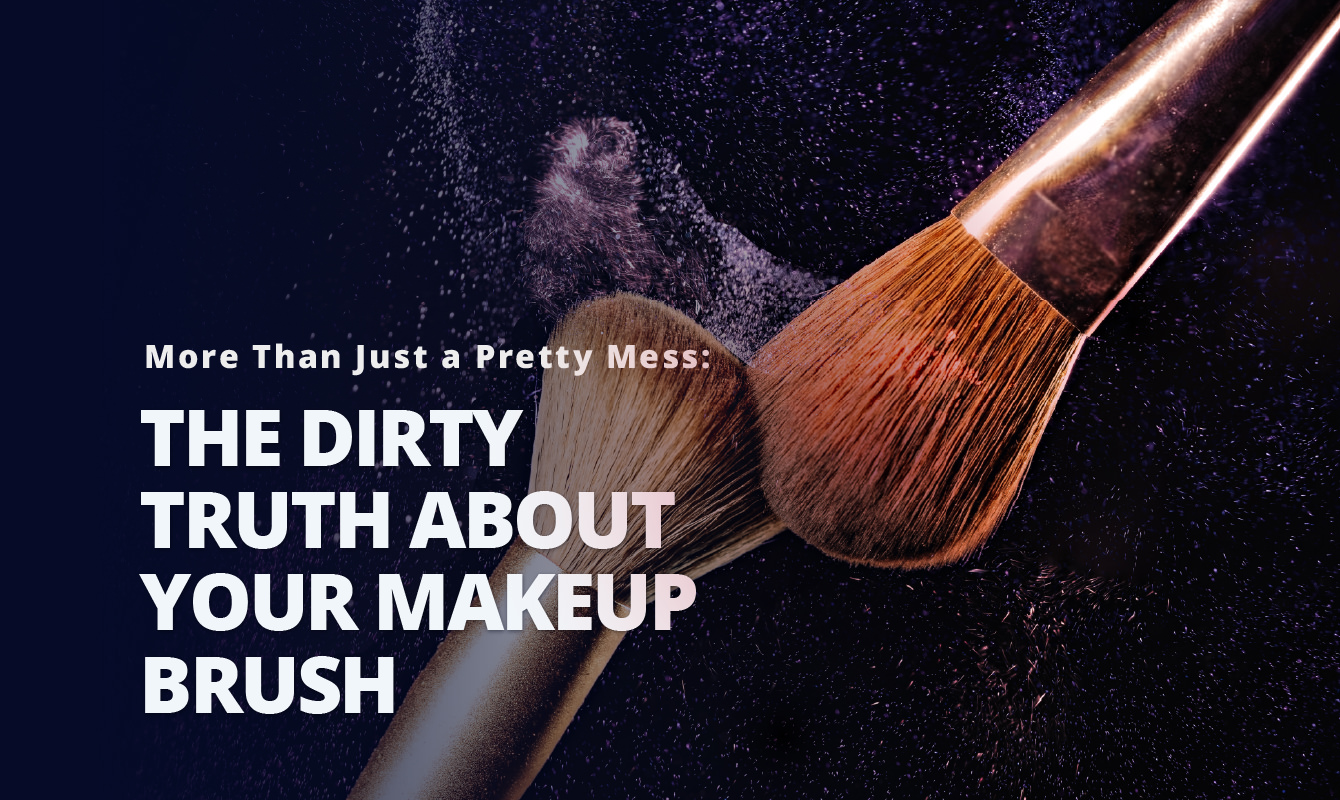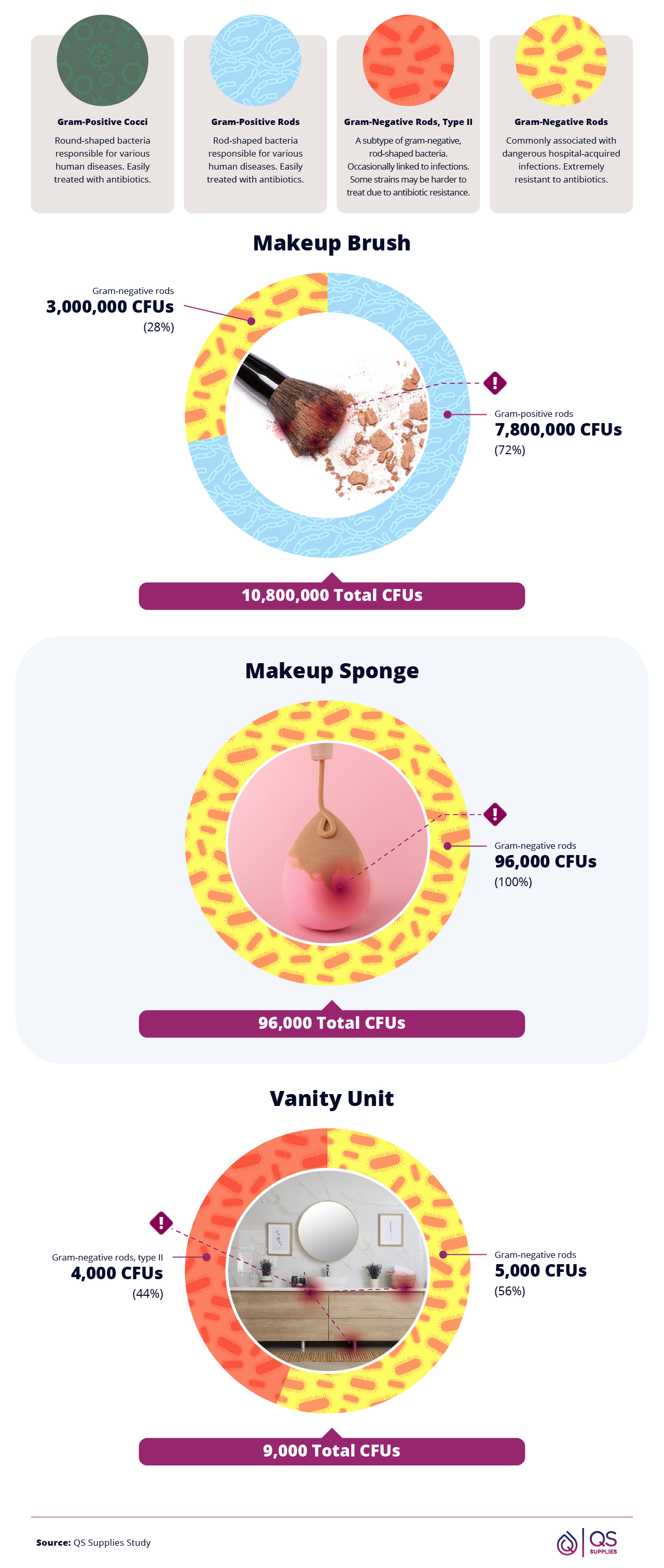
Most makeup users rarely think twice about the cleanliness of their brushes and sponges, but the bacteria lurking on these tools tell a different story. Our study reveals the shocking amount of microbial buildup on everyday beauty products, often surpassing some of the dirtiest public surfaces. This research highlights why regular cleaning is important, not just for hygiene but also for skin health.
Key Takeaways
- A makeup brush contains over 20,000x the bacteria of a toilet seat
- A makeup brush has 43x the bacteria of an airport check-in kiosk.
- A makeup sponge has nearly 7x the bacteria of a pet toy tennis ball.
- A bathroom vanity unit harbours 35x the bacteria of a bathroom doorknob.
Makeup Brushes and Sponges: Hidden Havens for Bacteria
Most people use their makeup tools daily, but few consider bacteria accumulating on them. To measure contamination, we swabbed makeup brushes, sponges, and bathroom surfaces and then tested the samples. The results measure bacteria in colony-forming units (CFUs), a count of the number of live bacteria that can grow and multiply.

Makeup brushes were the most contaminated item we tested, harbouring nearly 11 million CFUs. Of these, 72% were Gram-positive rods, bacteria commonly linked to skin infections. The remaining 28% were Gram-negative rods, which are known for their resistance to antibiotics. Makeup sponges contained 96,000 CFUs, with 100% identified as Gram-negative rods, suggesting a high potential for harmful microbial growth.
Even bathroom surfaces, where beauty tools are often used and stored, weren't free from bacteria. Swabs from a bathroom unit detected 9,000 CFUs, with 56% being Gram-negative rods and 44% classified as Gram-negative rods Type II — some of which are associated with respiratory infections.
Makeup Tools Harbour More Bacteria Than Everyday Surfaces
Most people assume that public surfaces like airport kiosks or toilet seats are the worst offenders for bacteria. However, our study found that beauty tools often harbour far more germs.

A makeup brush contained over 20,000 times the bacteria found on a toilet seat and 43 times the bacteria of an airport check-in kiosk — a surface touched by hundreds of travellers daily. A makeup sponge had nearly seven times the bacteria of a pet's tennis ball, an object often exposed to dirt and saliva.
The bathroom vanity unit, where many apply makeup and keep beauty tools, wasn't much better. It carried 35 times the bacteria of a bathroom doorknob. Clearly, keeping makeup tools and bathroom furniture clean is key to maintaining better hygiene.
Rethinking Makeup Hygiene: A Wake-Up Call
Makeup tools are a breeding ground for bacteria. Without regular cleaning and proper storage, brushes and sponges accumulate millions of bacteria, increasing the risk of skin irritation and infections. The good news? Keeping your makeup tools clean is easy:
- Wash brushes and sponges weekly using a gentle soap or brush cleanser, then let them air dry completely to prevent mould growth.
- Disinfect daily-use toolsstrong> with an antibacterial spray or wipe between washes.
- Store makeup tools properlystrong>, avoiding damp surfaces and dirty makeup bags.
- Clean your vanity areastrong> regularly to lessen bacteria transfer from to brushes and skin.
A little extra care can help keep your beauty routine safe and hygienic.
Methodology
For this study, we conducted three-gram and stain culture swab tests of makeup brushes and bathroom items. It's possible that with a larger sample size of surfaces, we could have gained more insight into CFU levels. No statistical testing was performed, and the above claims are based on means alone. As such, this content is exploratory. Bacteria definitions were sourced from ncbi.nlm.nih.gov, britannica.com, and sciencedirect.com.
About QS Supplies
QS Supplies is a premier retailer of high-quality bathroom products in the UK. Our extensive range includes luxurious shower enclosures, stylish basin taps, smart toilets and elegant bathroom furniture, ensuring your bathroom reflects your personal style and meets your practical needs.
Fair Use Statement
These findings may be shared for noncommercial purposes as long as you link to the original source.
